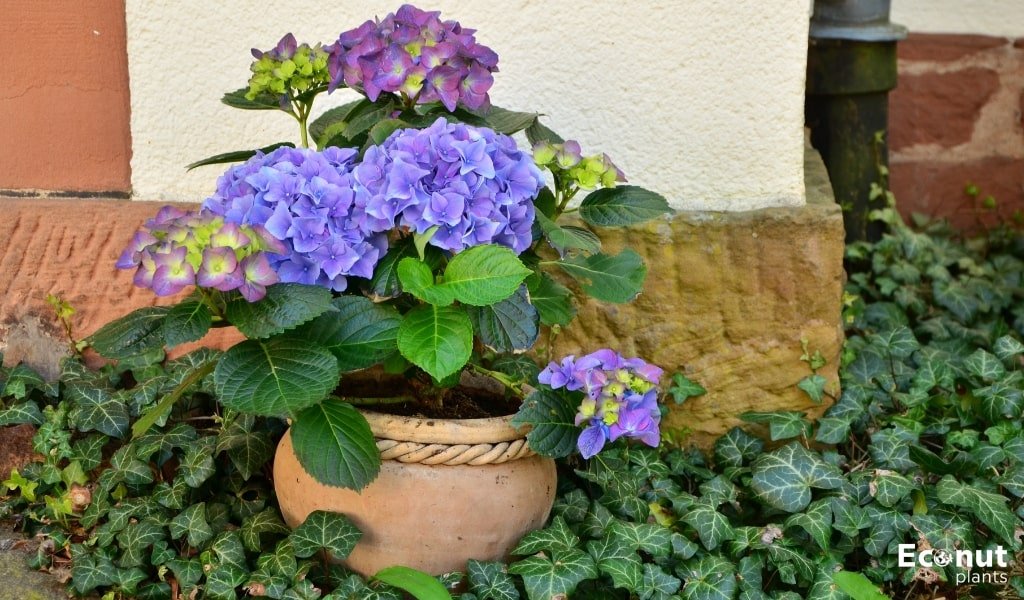Hydrangeas are incredibly well-liked blooming shrubs that look great in pots and add lovely blossoms to any container garden. You can still enjoy growing hydrangeas even if you don’t have much ground to plant them in, thanks to more compact varieties.
This season, are you considering growing some hydrangeas in containers? Planting in containers can occasionally be more of an art than a science. Here are some top ideas for gorgeous hydrangea flowers in pots or containers this season!
Hydrangeas Overview
| Common Name | Hydrangea |
| Botanical Name | Hydrangea spp. |
| Family | Hydrangeaceae |
| Plant Type | Shrub |
| Mature Size | 1-6 feet tall, 1-6 feet wide |
| Sun Exposure | Full, partial |
| Soil pH | Acidic |
| Bloom Time | Summer, fall |
| Toxicity | Toxic to humans and pets |
Choose the Right Hydrangea
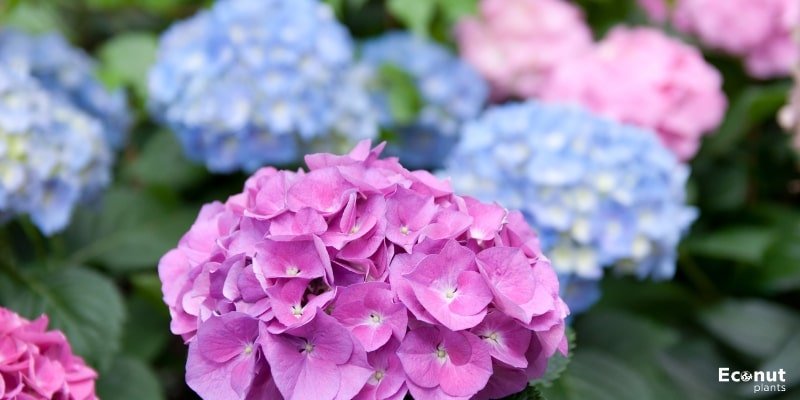
Depending on your goal, you can plant any hydrangea in a container. The dwarf variety will work best; they typically peak at one to three feet. You can just keep the larger variety you chose pruned to protect the container from getting too heavy.
Make sure to consider your zone when choosing your plant. This is not a concern if you want to treat the hydrangea as an annual or if you are in a region free from severe frosts. That being said, you should choose a hydrangea that is hardy in your region if you plan to overwinter your plants in a cold climate.
Variety Suggestions
When it comes to potted planting, hydrangea varieties differ from one another! Certain varieties do better in pots, depending on your climate and how well-cared for they are. Let’s have a look at some of the best hydrangeas for pots before you get started.
Hydrangea paniculata ‘Bobo’
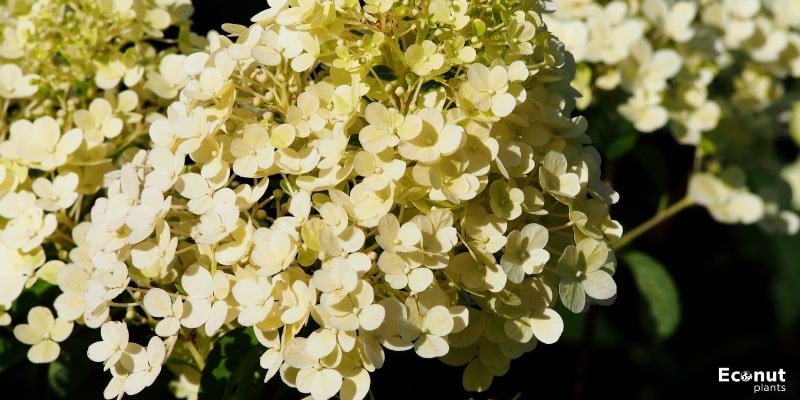
“Bobo” is a little panicle hydrangea that reaches a height and width of four feet. Lilacs are similar to panicle flowers. They are composed of tiny flowers and have a conical appearance. Big white blossoms that become pink in the autumn open in the summer.
Despite growing slowly, this hydrangea will reach its mature height in about two years because of its compact nature. Hardy zones 3–8.
Hydrangea macrophylla ‘Mini Penny’
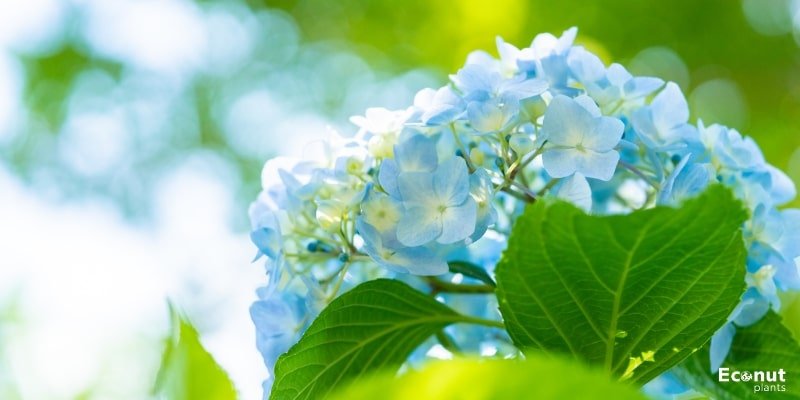
“Mini Penny” grows slowly and will reach a height and width of four feet when she is fully grown. This type of mophead is reblooming.
In acidic soil, the blossoms are blue; in sweeter soil, they are pink. When properly cared for, it blooms all summer until the first frost arrives. Hardy in zones 5 through 9.
Hydrangea quercifolia ‘Pee Wee’
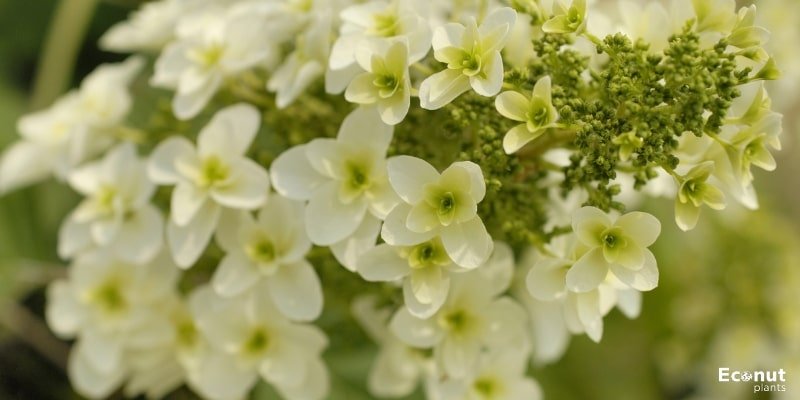
This oakleaf hydrangea’s white spring blossoms fade to pink in the autumn. Beautiful foliage that resembles oak leaves turns a vibrant scarlet in the autumn. Expands to four feet in height and three feet in width. Hardy in zones 5–9.
Goal Setting: Annual vs. Perennial
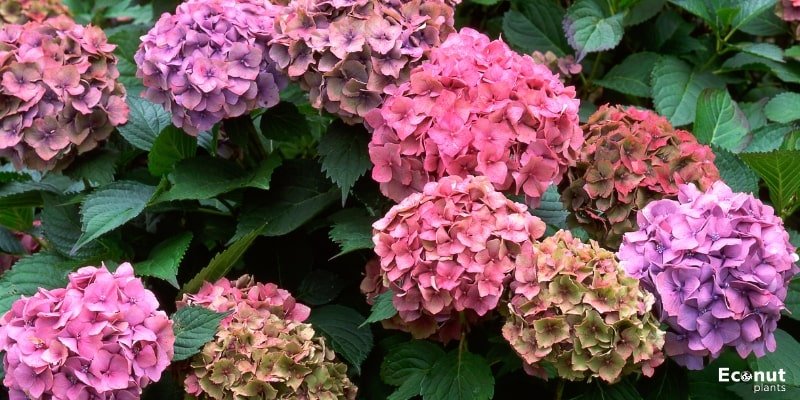
Selecting an annual or perennial hydrangea for your garden will largely depend on your climate before you begin planting. However, some individuals in perennial climates maintain hydrangeas as annuals despite this, so it’s crucial to ascertain your objectives beforehand.
Annual
There are truly “no limits” when it comes to treating hydrangeas as annuals. Unless you want to move it into your garden beds after the winter, you won’t be caring for the zone; therefore, you shouldn’t be concerned about it.
As for containers, you are likewise allowed to use whatever you choose. There will be a mess in the spring when several containers shatter or crack in frosty locations.
Perennial
Hydrangeas are perennials in their native climate. Treating them as annuals is not quite as liberating as treating them as perennials. If you are already a container gardener, though, all of this knowledge is rather basic.
First and foremost, make sure the hydrangea is hardy in your zone, especially if you often experience frost. Making the right kind of container choice is crucial. Size is by far the most important factor in this case. The container should be around two feet in width and two feet in depth.
Choose a Large Pot
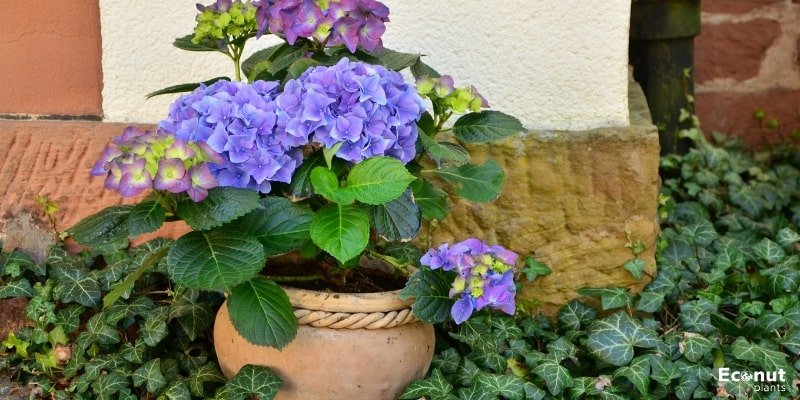
Growing hydrangeas will require a reasonably large pot. Their roots extend quickly, so they need space to grow. You may choose to set your pot on a plant caddie with wheels, depending on the material. From porcelain to plastic, there are a plethora of fantastic options available for containers. Find what your taste and money will allow!
Make sure the pot has a drainage hole on the bottom, as this is just as crucial as the container’s size! Wet soil does not appeal to hydrangeas.
All surplus water will be able to escape the plant through the drainage hole. If your container is in a spot you would prefer to keep clean, you might wish to set a draining dish underneath the pot.
Prepare Your Containers

It’s always a good idea to give your pots a thorough cleaning before putting anything in them. This will assist with getting rid of any bugs or illnesses.
Eliminate any leftover soil or plant debris from the previous growing season. You can vigorously scrub your pots or soak them in a large tub. Use a mild solution of vinegar or bleach to ensure that you have ruled out all potential problems.
Washing the pot, if you are using one made of terracotta, will help to keep the plant moist after planting. If your pots are plastic, you may merely scrub them well to get rid of any old debris or salt and mineral build-up instead of using bleach.
Use Correct Soil
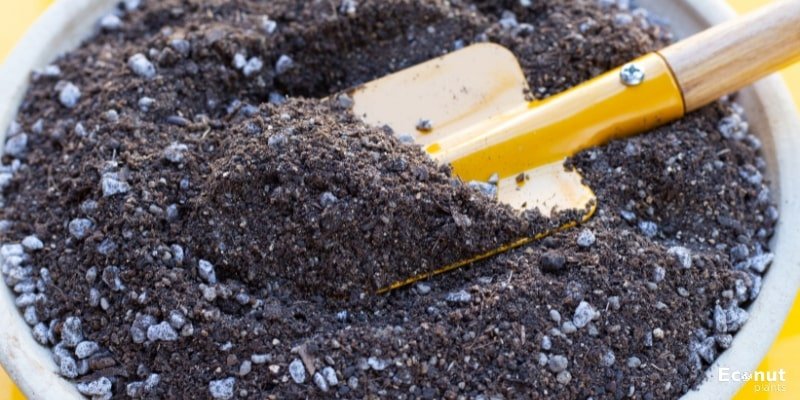
I know you’re itching to put some of your garden dirt in your gigantic pot, but please refrain! It is recommended to use potting soil when planting hydrangeas in containers. To provide your plants with the nutrients they need to flourish, potting soils frequently come pre-mixed with a basic plant fertilizer.
Overwetting and excessive density can occur in garden soil. A surplus of water can be disastrous for hydrangeas. An excessive amount of water surrounding your plant may cause its roots to deteriorate. Using potting soil will not only keep the container lighter, but will also make transporting it easier in due course.
Choose Your Companion Plants
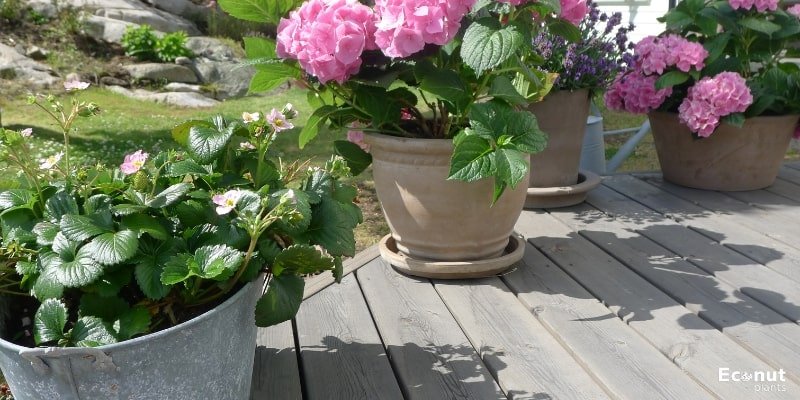
Of course, a hydrangea in a planter by itself will look stunning. Nonetheless, you can decide to add a few plants to accentuate your billowing beauty if you have a really large container to fill or if the hydrangea you bought is on the smaller side.
Huchera, ferns, and small hosta cultivars all have a lovely compact growth habit and comparable light requirements. Begonias and some coleus cultivars are two more shade-loving annuals that would look fantastic with hydrangea clusters.
Although the growth of both of these plants is more erect, the variety of colours that are available might truly give your container a bright, summery punch.
Plant Your Hydrangea Correctly
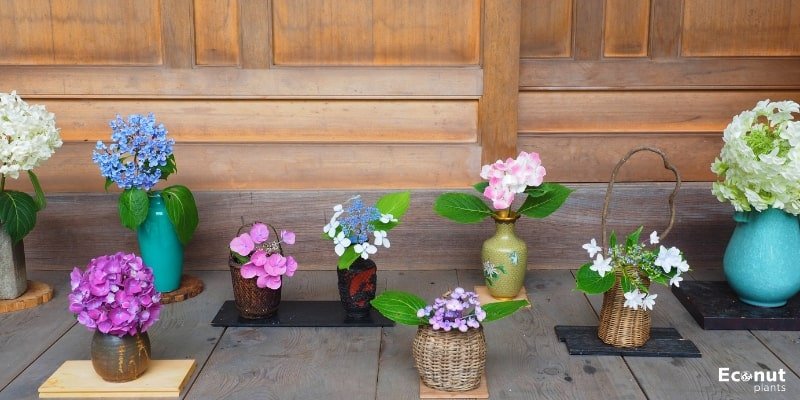
Planting hydrangeas is a rather simple process. While your hydrangea is still in its nursery pot, give it a thorough watering before preparing your container.
You should fill the bottom of your container with potting soil, depending on its size. You’ll have to make the final decision here because you want to keep the plant at the same depth as it is in the nursery pot.
After placing the plant inside, lightly pack the soil around it. After giving it a thorough soak, you should be able to see water dripping out of the container’s bottom.
Provide Proper Sunlight
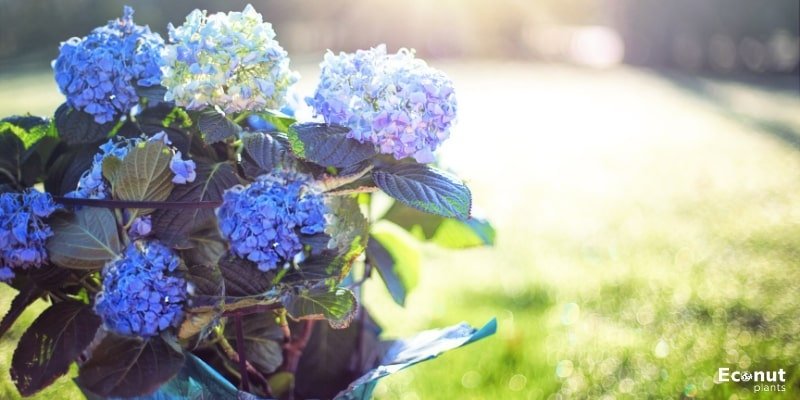
Most hydrangeas like some sun, especially in the early and afternoon shadows. Hydrangea paniculata relishes a minimum of six hours of sunlight exposure. To avoid excessive water loss, your hydrangea would greatly benefit from some afternoon shade if you live in a warmer environment.
You will be set for success if you position your container where these kinds of sunlight are present. The good news is that moving a containerized plant is considerably easier than moving one that is in the ground, so you can experiment a little with placement. There are full-sun hydrangea cultivars that are probably a better fit if you are planting in a sunny spot.
Choose Your Spot Carefully
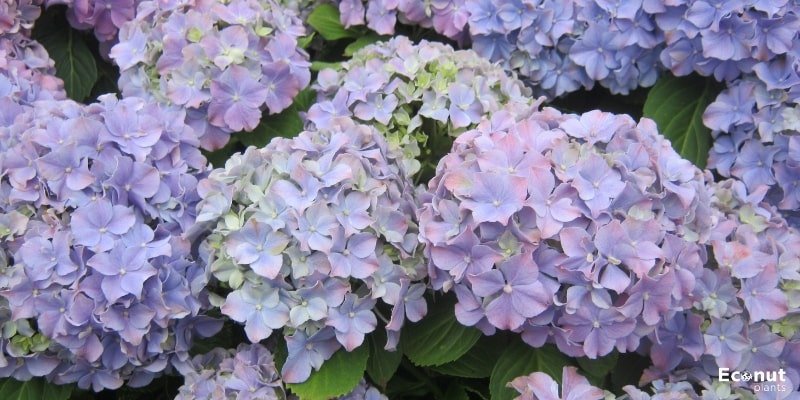
Potted hydrangeas are a great plant choice for a front porch, balcony, patio, surrounding a pool, under a covered porch, on top of an old tree stump, etc.
Since they provide long-lasting flowers with no maintenance. Remember that hydrangea can be poisonous to pets when considering your location. Don’t let your cats or dogs near them!
Provide Enough Water
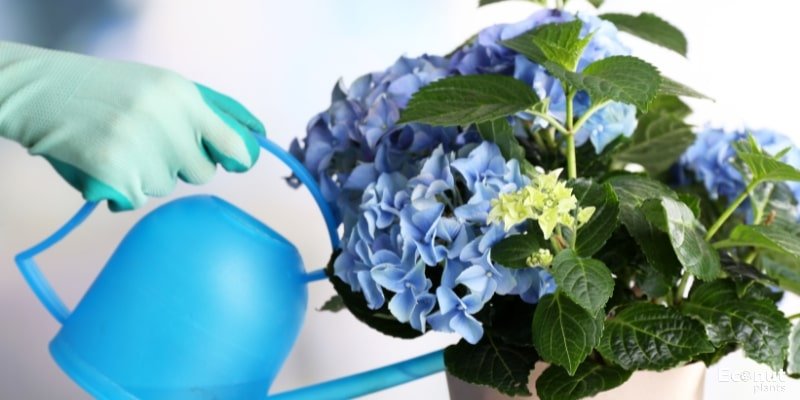
Compared to your plant beds, containers often dry up considerably faster. Watering your hydrangeas thoroughly twice a week should be enough. As soon as the temperature rises, pay attention to the leaves. When hydrangeas are thirsty, their leaves may start to droop. The soil should be moist up to one inch down.
The easiest method to check if you need to water or not is to just insert your finger into the potting soil! As the hydrangea grows, its root system will probably require more regular watering because of the growing number of roots and shrinking pot capacity.
Fertilize When Necessary
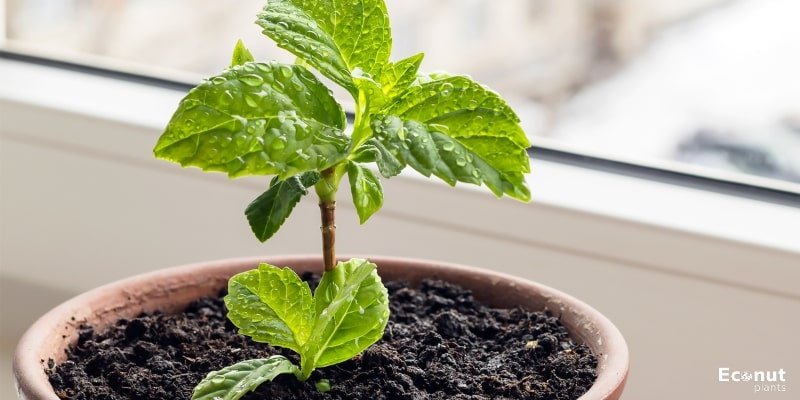
The best technique to fertilize your hydrangea plant is to sprinkle some compost or manure around the base of the plant as you water it. This will yield good outcomes for you. The potting soil you chose should contain enough fertilizer to get you through the first growth season.
If you do decide to keep your hydrangeas in containers year-round, you should fertilize them in the spring using an all-purpose fertilizer for flowering shrubs. Don’t fertilize after August, and make sure the fertilizer is well absorbed into the soil.
The plant may sprout new growth as a result of this. Late-season new growth may make the plant more susceptible to frost damage and reduce the number of flowers the next year.
Pruning Makes Perfect
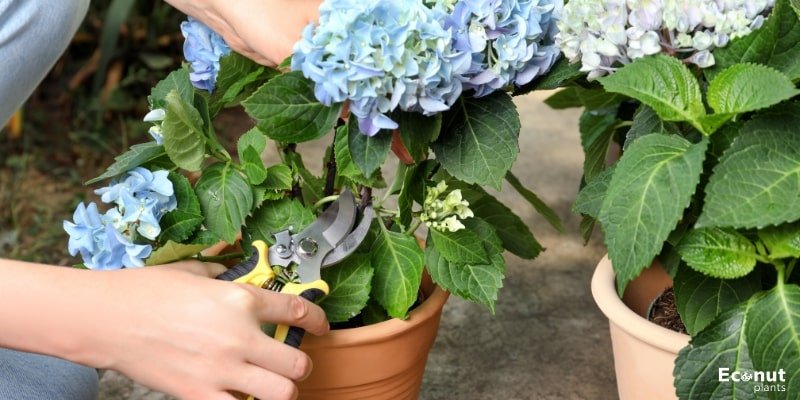
Deadheading is all you should be concerned with when it comes to “pruning” potted hydrangeas. To keep your preferred shape, you may want to sometimes trim a few branches.
Alternatively, you might need to trim off any sections that the ice has damaged. To make sure you aren’t chopping off any freshly developed flower buds, perform these two types of trimming right before the blooming season ends.
Transplant When Needed
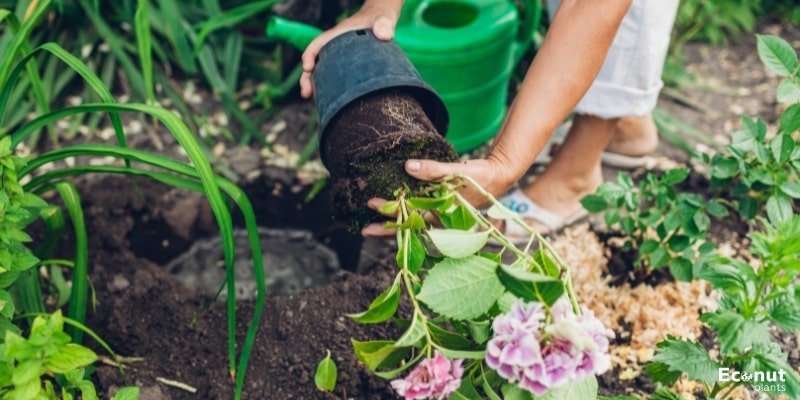
You may notice that your hydrangea isn’t performing as well as it once did after a few years of residing in your container. Do not worry. It probably just needs more space to spread out and would be better off being moved out of your container.
Either move it into a bigger pot that you already have or move it into your garden. It all depends on how much space you have and what your gardening objectives are, but they are both excellent choices.
Make sure the roots have enough space to spread out and avoid burying the plant’s base. Before replanting your hydrangea, you should remove any roots that have begun to get pot-bound and wrap around the earth.
Always Over-winter
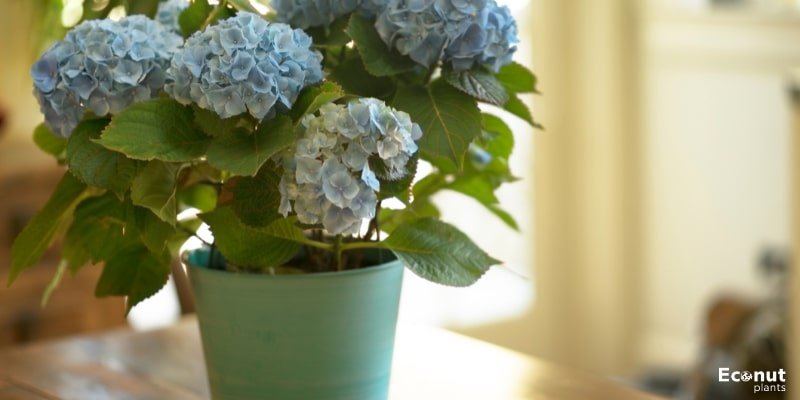
Once a frost strikes in the winter, you will need to prepare for how you will care for your hydrangea. Improper overwintering may result in plant loss or stop hydrangea blooming.
If you have the space, you can relocate your potted hydrangeas into your garage or an unheated she rather quickly. It will be cool enough for them to go through their typical cycle, but not so cold that they are protected from the wind and harsh frosts.
You can cover your hydrangea pots with straw to keep the roots warm while leaving them in place. For the following season’s blooms, hydrangeas need enough cold.
Conclusion
Add some hydrangeas to your containers to make them stand out for this season and many more to come. The leaves are colourful and abundant from April until the first frost. There is nothing like flowers.
Compared to some flowering plants that require daily or weekly care, this one requires less. There are lots of fun types that will grow well in your pots. You won’t regret your choice, whatever it may be!

